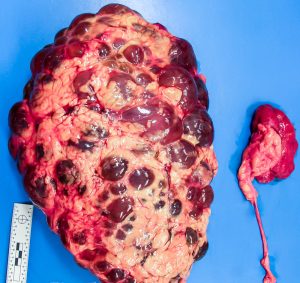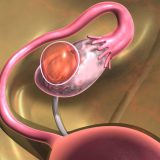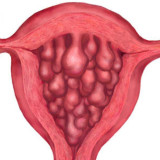Kidneys perform very important functions in our bodies. They are primarily responsible for the excretion of harmful metabolic products with the urine, and also have a significant impact on the acid-alkaline balance of the whole body. They also perform other functions, so it is important to monitor their health. Especially since the number of kidney diseases is quite big.
Kidney cyst is one of the most common diseases of this paired organ. The formation of these pathological kidney tumors leads to the fact that the kidneys stop working properly.
What is a kidney cyst
A kidney cyst is nothing more than a cavity formed on or in the organ. As a rule, it consists of one or more cavities filled with liquid. Kidney cysts can occur in both men and women. However, according to some reports in men cystic kidney disease is more common.
Types of kidney cyst
Simple renal cyst
In the case of a simple renal cyst, as a rule, one cavity appears. This type of cystic kidney disease occurs in 30% of adults, and their incidence increases with age. A simple renal cyst can grow in size over time.
Symptoms
Usually, simple renal cysts have no symptoms and are detected occasionally.
However, it happens that if they are large, and their size exceeds 5 cm, they can give symptoms in the form of pain in the side or pain in the lumbar region of the spine.
It also happens that the symptom of a simple renal cyst is a feeling of overflow and abdominal pressure and nonspecific gastrointestinal symptoms.
Sometimes there are, although rarely, complications of simple renal cyst, which include infection of the contents of the cyst and hematuria.
Diagnostics
Since a simple kidney cyst of small size has no specific symptoms, it is usually detected accidentally during abdominal ultrasound, computed tomography or magnetic resonance imaging of the abdominal cavity.
If the above symptoms are present, you should immediately consult a doctor to make an ultrasound.
Treatment
A simple kidney cyst with no symptoms doesn’t require treatment. The doctor watches it, controls its development with the help of ultrasound of the abdominal cavity, and soon it will disappear itself.
However, if a simple renal cyst gives symptoms (especially abdominal pain or lumbar pain in the spine) or if it presses on adjacent organs, then the treatment is emptying the cavity of the simple kidney cyst and sclerotization (injection into a cyst with 95% ethanol) or surgical removal of the cyst.
Polycystic kidney disease
Another type of renal cyst is polycystic kidney disease. There are an autosomal dominant and autosomal recessive forms.
Autosomal dominant form of kidney polycystic is the most common genetically determined form of kidney diseases. It is usually detected at the age of 10 to 30 years and is the cause of about 10-15% of cases of end-stage renal failure, requiring organ replacement.
Although autosomal recessive form is not so common, it is no less dangerous. And it occurs even in children during prenatal examination.
Symptoms
As in the case of a simple kidney cyst, the disease at an early stage has no symptoms. For many years, the cystic kidney disease may be asymptomatic and relatively often detected by accident during abdominal ultrasound or other imaging tests performed for completely different reasons.
But, there are some symptoms that can occur with the development of the disease, although they are not specific.
The first symptom may be hypertension. In addition, a typical symptom of polycystic kidney degeneration may also be pain in the lumbar region of the spine, as well as hematuria, which is a consequence of the rupture of the cyst. In some patients kidney stones develop, sometimes also present cysts of other organs occur. For example, in polycystic kidney disease, cysts can also be found in the liver or pancreas.
Diagnosis
This disease is diagnosed by abdominal ultrasound, computed tomography or magnetic resonance imaging, often these tests are performed for a completely different reason, and the diagnosis of the kidneys cysts is accidental.
Treatment
Unfortunately, the presence of this disease leads to chronic renal failure. Therefore, treatment of polycystic kidney is symptomatic and supportive.
Acquired renal cysts
 Another type of renal cyst is acquired cystic kidney disease. This diagnosis is made when four or more cysts are found in each kidney in a person with chronic kidney disease, and the doctor is sure that it is not polycystic.
Another type of renal cyst is acquired cystic kidney disease. This diagnosis is made when four or more cysts are found in each kidney in a person with chronic kidney disease, and the doctor is sure that it is not polycystic.
This disease occurs in people with chronic renal failure, regardless of its cause, especially in people who are undergoing renal replacement therapy.
Symptoms and diagnosis
The etiology of this disease is not yet known. In most cases, cysts usually do not cause any discomfort, but they can also cause hematuria, pain in the lumbar region or renal colic.
Diagnosis of the disease is based on abdominal ultrasound.
Treatment
Treatment is not required if the cystic kidney disease does not show any symptoms.
In the case of hematuria, bed rest and painkillers are recommended.
Sometimes, in case of permanent hematuria or in the case of cystic infection or suspected cancer, surgical treatment is necessary.
Remember, a kidney cyst doesn’t always mean disease. Sometimes it’s just a change in the organ that we have and nothing happens to it. In this case, do not worry, it requires only periodic monitoring with ultrasound.














